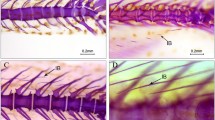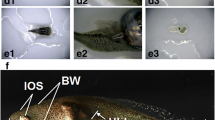Abstract
Serum response factor (SRF) is a MADS-box transcription factor that regulates the expression of genes involved in development, metabolism, cell proliferation, and differentiation. In the present study, we cloned the full-length SRF cDNA which includes the coding region of 1503 bp, a 573-bp 5′untranslated region (UTR) and a 400-bp 3′-UTR. The deduced 501 amino acid sequence of the SRF protein contained a MADS domain and NLS at the N terminus, similar to other organisms, and it also is highly phylogenetically conserved. SRF mRNA is ubiquitously expressed in various tissues, with the highest level in the kidneys, and it is also highly expressed during the embryonic and metamorphic stages. During metamorphosis, the SRF mRNA levels are down-regulated by exogenous thyroid hormone (TH) at 17 dph and by thiourea (TU) at 29, 36, and 41 dph, whereas SRF mRNA levels were significantly up-regulated by the added exogenous TH to the TU-treated larvae at 41 dph, which indicates that thyroid hormone is essential for expression of SRF mRNA, so, higher levels of TH did not result in changes of SRF mRNA levels, while TH deficiency or inhibited by the non-specific TU toxicity cause down-regulation of SRF mRNA, which indicated that TH can indirectly affect the SRF mRNA levels. Meanwhile, using a luciferase reporter assay, we verified that SRF is a common target gene of miR-133a which is a muscle-specific microRNA (miRNA), which indicated that SRF may be involved in the signaling pathway of miRNA that regulates muscle development.







Similar content being viewed by others
References
Arsenian S, Weinhold B, Oelgeschläger M, Rüther U, Nordheim A (1998) Serum response factor is essential for mesoderm formation during mouse embryogenesis. The EMBO J 17:6289–6299
Barron MR, Belaguli NS, Zhang SX, Trinh M, Iyer D et al (2005) Serum response factor, an enriched cardiac mesoderm obligatory factor, is a downstream gene target for Tbx genes. J Biol Chem 280:11816–11828
Belaguli NS, Schildmeyer LA, Schwartz RJ (1997) Organization and myogenic restricted expression of the murine serum response factor gene a role for autoregulation. J Biol Chem 272:18222–18231
Chen CY, Schwartz RJ (1996) Recruitment of the tinman homolog Nkx-2.5 by serum response factor activates cardiac alpha-actin gene transcription. Mol Cell Biol 16:6372–6384
Chen SL, Ren GC, Sha ZX, Shi CY (2004) Establishment of a continuous embryonic cell line from Japanese flounder Paralichthys olivaceus for virus isolation. Dis Aquat Org 60:241–246
Chen JF, Mandel EM, Thomson JM, Wu Q, Callis TE et al (2006) The role of microRNA-1 and microRNA-133 in skeletal muscle proliferation and differentiation. Nat Genet 38:228–233
Croissant JD, Kim JH, Eichele G, Goering L, Lough J et al (1996) Avian serum response factor expression restricted primarily to muscle cell lineages is required for alpha-actin gene transcription. Dev Biol 177:250–264
Dalton S, Marais R, Wynne J, Treisman R (1993) Isolation and characterization of SRF accessory proteins. Philos Trans R Soc Lond B Biol Sci 340:325–332
Ding W, Witte MM, Scott RE (1999) Transformation blocks differentiation-induced inhibition of serum response factor interactions with serum response elements. Cancer Res 59:3795–3802
Drummond MJ, Glynn EL, Fry CS, Dhanani S, Volpi E et al (2009) Essential amino acids Increase MicroRNA-499,-208b, and-23a and downregulate myostatin and myocyte enhancer factor 2C mRNA expression in human skeletal muscle. J Nutr 139:2279–2284
Elia L, Contu R, Quintavalle M, Varrone F, Chimenti C et al (2009) Reciprocal regulation of MicroRNA-1 and insulin-like growth factor-1 signal transduction cascade in cardiac and skeletal muscle in physiological and pathological conditions. Circulation 120:2377–2385
Fleige A, Alberti S, Gröbe L, Frischmann U, Geffers R et al (2007) Serum response factor contributes selectively to lymphocyte development. J Biol Chem 282:24320–24328
Fu YS, Shi ZY, Wang GY, Li WJ, Zhang JL et al (2012) Expression and regulation of miR-1,-133a,-206a, and MRFs by thyroid hormone during larval development in Paralichthys olivaceus. Comp Biochem Physiol B-Biochem Mol Biol 161:226–232
Fu YS, Shi ZY, Wang GY, Zhang JL, Li WJ et al (2013) Expression of let-7 microRNAs that are involved in Japanese flounder (Paralichthys olivaceus) metamorphosis. Comp Biochem Physiol B-Biochem Mol Biol 165:106–113
Gauthier-Rouvière C, Cavadore JC, Blanchard JM, Lamb NJ, Fernandez A (1991) p67SRF is a constitutive nuclear protein implicated in the modulation of genes required throughout the G1 period. Cell Regul 2:575–588
Gineitis D, Treisman R (2001) Differential usage of signal transduction pathways defines two types of serum response factor target gene. J Biol Chem 276:24531–24539
Inui Y, Miwa S (1985) Thyroid hormone induces metamorphosis of flounder larvae. Gen Comp Endocrinol 60:450–454
Inui Y, Yamano K, Miwa S (1995) The role of thyroid hormone in tissue development in metamorphosing flounder. Aquaculture 135:87–98
Kim LK, Choi UY, Cho HS, Lee JS, Lee WB et al (2007) Down-regulation of NF-kappaB target genes by the AP-1 and STAT complex during the innate immune response in drosophila. PLoS Biol 5:e238
Klamut HJ, Gangopadhyay SB, Worton RG, Ray PN (1990) Molecular and functional analysis of the muscle-specific promoter region of the Duchenne muscular dystrophy gene. Mol Cell Biol 10:193–205
Li S, Czubryt MP, McAnally J, Bassel-Duby R, Richardson JA et al (2005) Requirement for serum response factor for skeletal muscle growth and maturation revealed by tissue-specific gene deletion in mice. Proc Natl Acad Sci USA 102:1082–1087
Liu HW, Halayko AJ, Fernandes DJ, Harmon GS, McCauley JA et al (2003) The RhoA/Rho kinase pathway regulates nuclear localization of serum response factor. Am J Respir Cell Mol Biol 29:39–47
Liu N, Bezprozvannaya S, Williams AH, Qi X, Richardson JA et al (2008) microRNA-133a regulates cardiomyocyte proliferation and suppresses smooth muscle gene expression in the heart. Genes Dev 22:3242–3254
Livak KJ, Schmittgen TD (2001) Analysis of relative gene expression data using real-time quantitative PCR and the 2[-delta delta C(T)] method. Methods 25:402–408
Miano JM (2003) Serum response factor: toggling between disparate programs of gene expression. J Mol Cell Cardiol 35:577–593
Miano JM, Ramanan N, Georger MA, de Mesy Bentley KL, Emerson RL et al (2004) Restricted inactivation of serum response factor to the cardiovascular system. Proc Natl Acad Sci USA 101:17132–17137
Miano JM, Long XC, Fujiwara K (2007) Serum response factor: master regulator of the actin cytoskeleton and contractile apparatus. Am J Physiol-Cell Physiol 292:C70–C81
Miwa S, Tagawa M, Inui Y, Hirano T (1988) Thyroxine surge in metamorphosing flounder larvae. Gen Comp Endocrinol 70:158–163
Parlakian A, Tuil D, Hamard G, Tavernier G, Hentzen D et al (2004) Targeted inactivation of serum response factor in the developing heart results in myocardial defects and embryonic lethality. Mol Cell Biol 24:5281–5289
Pirhonen J, Matikainen S, Julkunen I (2002) Regulation of virus-induced IL-12 and IL-23 expression in human macrophages. J Immunol 169:5673–5678
Reese JC (2003) Basal transcription factors. Curr Opin Genet Dev 13:114–118
Schreiber AM, Specker JL (1998) Metamorphosis in the Summer Flounder Paralichthys dentatus: stage-specific developmental response to altered thyroid status. Gen Comp Endocrinol 111:156–166
Sepulveda JL, Vlahopoulos S, Iyer D, Belaguli N, Schwartz RJ (2002) Combinatorial expression of GATA4, Nk2–5, and serum response factor directs early cardiac gene activity. J Biol Chem 277:25775–25782
Townley-Tilson WH, Callis TE, Wang D (2010) MicroRNAs 1, 133, and 206: critical factors of skeletal and cardiac muscle development, function, and disease. Int J Biochem Cell Biol 42:1252–1255
Treisman R (1985) Transient accumulation of c-fos RNA following serum stimulation requires a conserved 5′ element and c-fos 3′ sequences. Cell 42:889–902
Vandromme M, Gauthier-Rouviere C, Carnac G, Lamb N, Fernandez A (1992) Serum response factor p67SRF is expressed and required during myogenic differentiation of both mouse C2 and rat L6 muscle cell lines. J Cell Biol 118:1489–1500
Vickers ER, Kasza A, Kurnaz IA, Seifert A, Zeef LA et al (2004) Ternary complex factor-serum response factor complex-regulated gene activity is required for cellular proliferation and inhibition of apoptotic cell death. Mol Cell Biol 24:10340–10351
Wei L, Zhou W, Croissant JD, Johansen FE, Prywes R et al (1998) RhoA signaling via serum response factor plays an obligatory role in myogenic differentiation. J Biol Chem 273:30287–30294
Williams AH, Liu N, van Rooij E, Olson EN (2009) MicroRNA control of muscle development and disease. Curr Opin Cell Biol 21:461–469
Yamano K, Miwa S, Obinata T, Inui Y (1991) Thyroid hormone regulates developmental changes in muscle during flounder metamorphosis. Gen Comp Endocrinol 81:464–472
Zhang X, Azhar G, Helms SA, Wei JY (2010) Regulation of cardiac micrornas by serum response factor. Gerontologist 50:183
Zhao Y, Samal E, Srivastava D (2005) Serum response factor regulates a muscle-specific microRNA that targets Hand2 during cardiogenesis. Nature 436:214–220
Acknowledgments
The authors thank Prof. Haijin Liu (Chinese Academy of Fishery Sciences) for providing the experimental fish and Songlin Chen (Yellow Sea Fisheries Research Institute of the Chinese Academy) for the FEC cells. This research was supported by the National Natural Science Foundation of China (No. 31172392) and the Dr. Foundation of Shanghai Ocean University (A-0209-13-0105387).
Author information
Authors and Affiliations
Corresponding author
Additional information
Yanfang Su and Yuanshuai Fu have contributed equally to this article.
Rights and permissions
About this article
Cite this article
Su, Y., Fu, Y., Zhang, H. et al. Identification and expression of SRF targeted by miR-133a during early development of Paralichthys olivaceus . Fish Physiol Biochem 41, 1093–1104 (2015). https://doi.org/10.1007/s10695-015-0071-8
Received:
Accepted:
Published:
Issue Date:
DOI: https://doi.org/10.1007/s10695-015-0071-8




